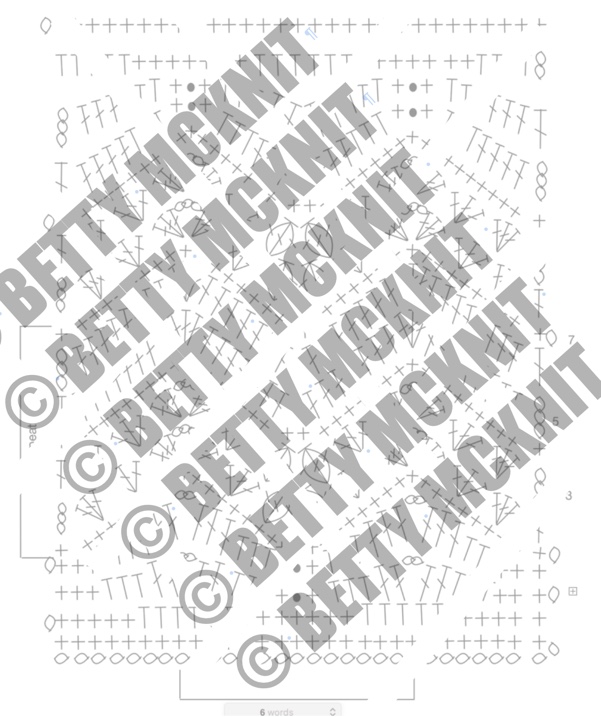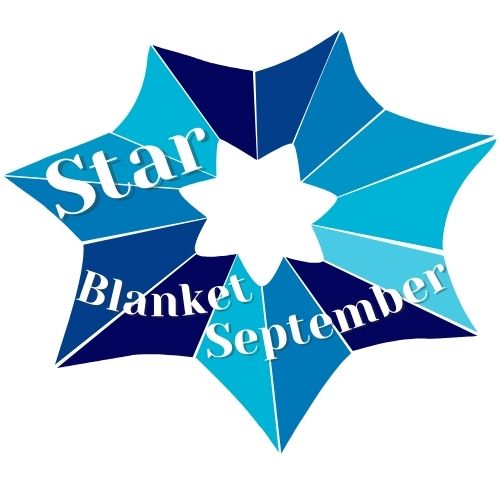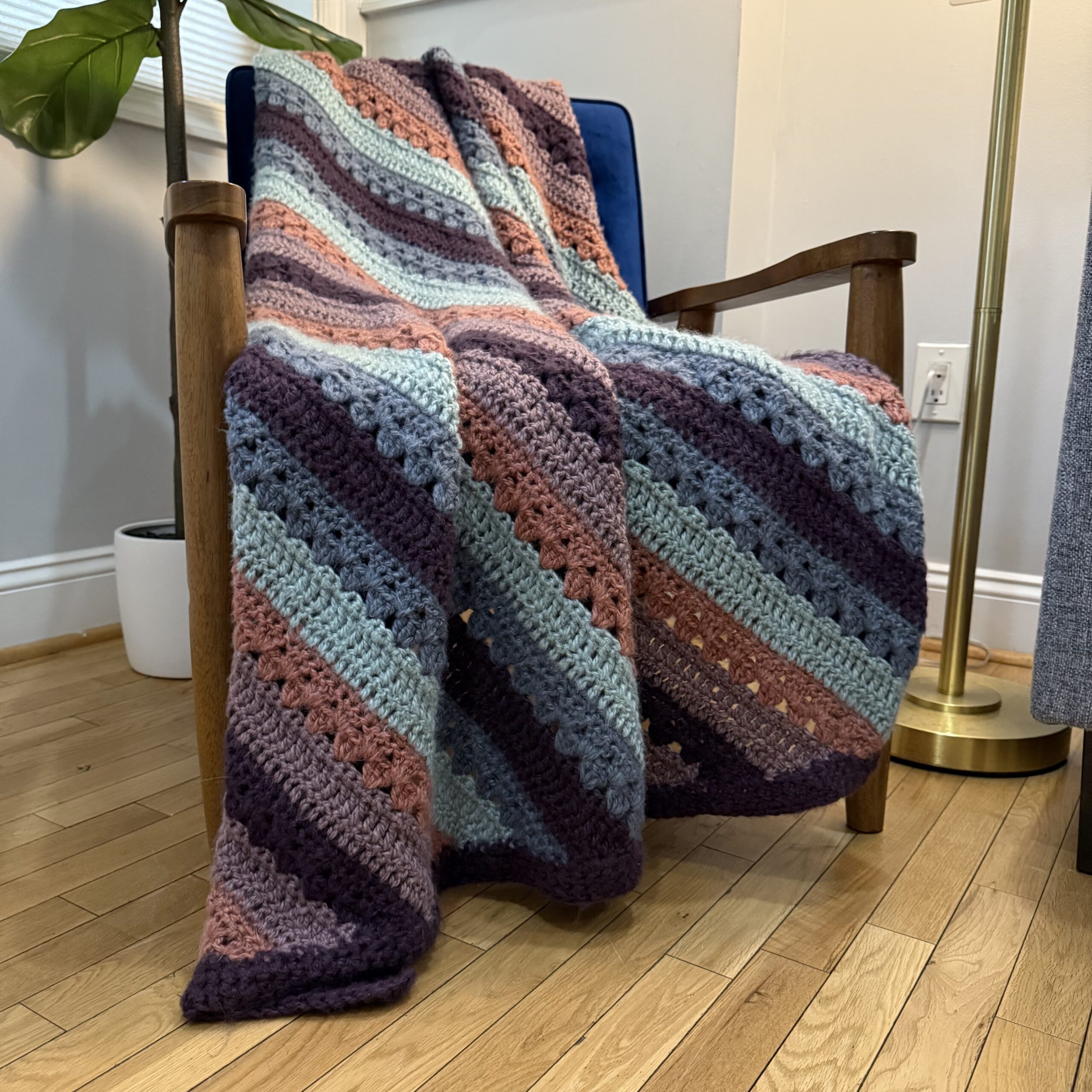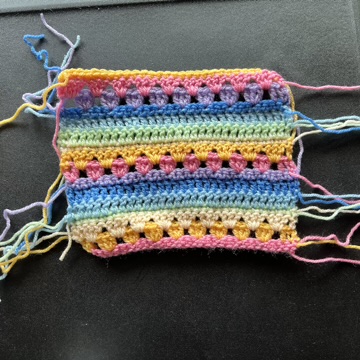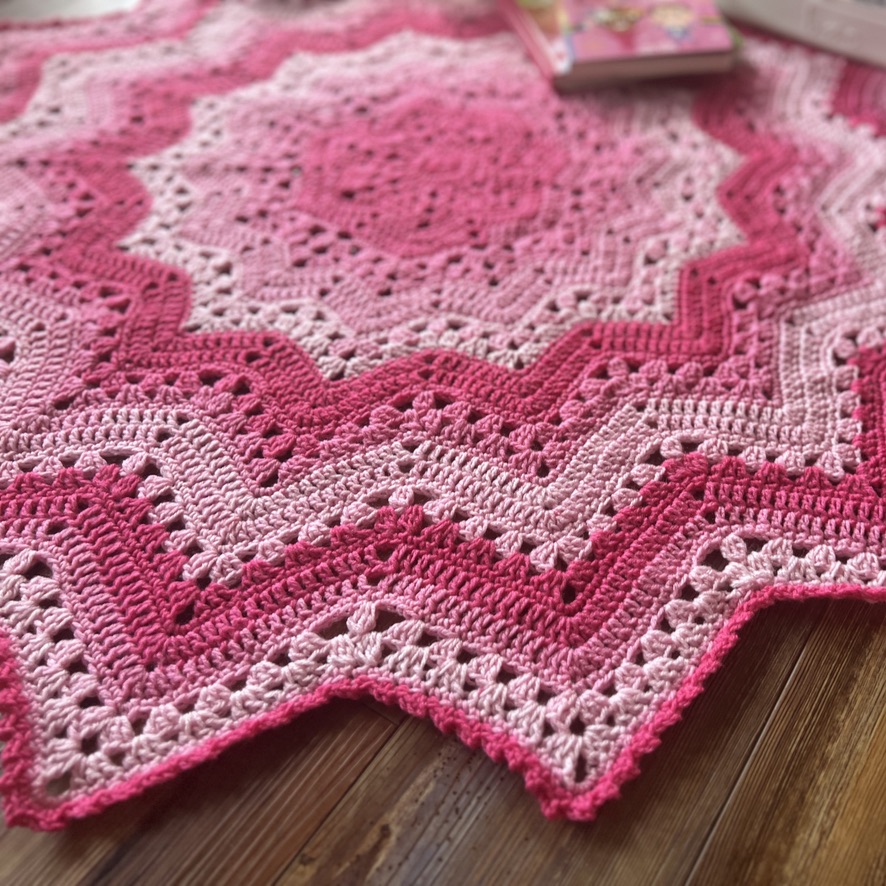6-Day Ridgy Didge Baby Blanket
A variation of the classic crochet pattern
the 6-Day Kid Blanket by Betty McKnit
This page contains affiliate links. If you click these links and buy something on the page they take you to, I may, at no additional cost to you, earn a commission. I only affiliate with products and companies I feel good about. Thank you for your support!
Introduction
This blanket is a variation on the classic 6-Day Kid Blanket (6DKB). This textured stripe was conceptualized by Diane Kagay and members of the 6-Day Blanket Group and was named by Sue McKinnon and Katie Poli.
I used the textured Ridgy Didge stripes as inspiration to create this new border.
There is a full-sized version of this pattern in the works called the 6-Day Ridgy Didge Blanket. It has been pre-released in the Betty McKnitiverse. Join now for immediate access to this and other pre-releases.
Details:
US Terminology
Finished Size: 38” x 42” (baby blanket size)
Gauge: 3.5 st/in and 4 rows/in dc
Skill Level: Easy
2000m/2400 yards total DK weight in five colors
Shown in: Stylecraft Special DK, Color A: Cream, Color B: Duck Egg, Color C: Vintage Peach, Color D: Turquoise, Color E: Toy (one ball of each)
Hook: Furls Odyssey G (4 mm) and G+ (4.5 mm) hook

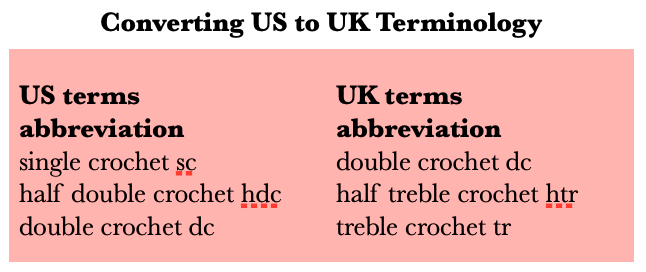
Abbreviations:
ch: chain
dc: double crochet
dc3tog: (this is a cluster and not a decrease. See Special Stitches below).
BPdc: back post double crochet
BPhdc: back post half double crochet
BPsc: back post single crochet
FPdc: front post double crochet.
FPhdc: front post half double crochet
FPsc: front post single crochet
hdc: half double crochet
rep: repeat
sc: single crochet
sk: skip
sl st: slip stitch
sp(s): space(s)
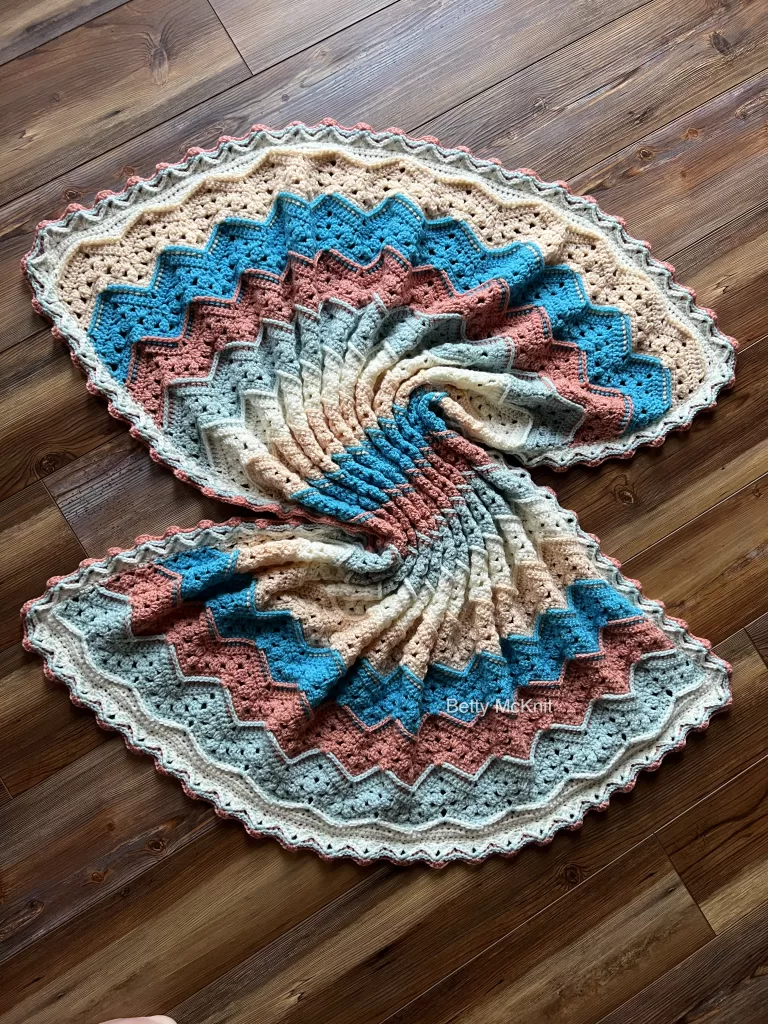
Special Stitches
dc3tog – worked as a cluster into one stitch – not over three stitches
[yarn over, pull up a loop, pull through two loops] 3 times. Yarn over, and pull through all 4 loops on the hook. (Be sure to pull up a loop in the same stitch every time.) dc3tog complete.
Back Post and Front Post Stitches
Back post stitches are worked from the back around the stitch in the row below. Front post stitches are worked from the front around the post of the stitch in the row below.
Does it really only take 6 Days to make?
The original 6DKB was a toddler sized blanket made with chunky yarn and took me six days of easy crochet – about two hours per day – to make. This variation uses the very similar stitches but uses a different weight yarn. I believe it can be done in six days depending on your skill level and speed, but my advice is to give yourself a couple of extra days.
First timers
If this is your first time making a 6-Day Kid Blanket, before you begin, I suggest you make a swatch while following along with my video tutorials on my YouTube Channel. I know you probably never swatch and will be tempted to bypass this advice, but take my word for it. The first few rows are a little tricky and you’ll sidestep common mistakes and avoid the frustration of frogging hours of hard work by swatching along with my tutorials before starting your blanket.
How to Resize
This pattern creates a baby blanket. No options for resizing are offered in this pattern. If you would like make this blanket in a different size, please see the 6-Day Ridgy Didge Blanket, the original 6-Day Kid Blanket pattern, and my 6DKB Resize Video.
Stripe Symmetry
If you choose to use more than five colors on this pattern, you will need to plan ahead to make your stripes symmetrical on the top and bottom. See my note below about changing colors and plan ahead for the first and last stripes to match.
Side edges
Some crocheters have had issues with the side edges of their blankets curling. Keep in mind that some curling is normal and can be corrected when your border your blanket and wash it. If you find that curling is excessive, here are some steps you can take to help alleviate it. Try them out on your swatch. You will most likely not need all of these options, but a combination of one or more should the trick.

- ch 4 at the beginning of the row where the instructions say to ch 3. This is something you should try in your swatch, as some crocheters with tighter tension find that they really do need that extra stitch. Others do fine without it.
- Replace the dc at the end of row 2 and 3 with extended double crochet (edc). Keep in mind when adding additional chains or edc on the edge you may need to skip stitches when working along the sides to get your edges to lie flat. There is no exact formula for how many sc to work into the side edges. Use your judgement and lay it down often and check it as you are working.
- When working the last stitch of the row, insert the hook from back to front, instead of from front to back.
- Work an edge into the turning chains and sc/dc stitches on the sides of the work as described at the end of this pattern, rather than into the spaces.
- Wash your blanket once it is complete, and lay it out flat to dry, gently stretching and shaping the edges.
Changing Colors
No two 6-Day Blankets are alike. The 6-Day Kid Blanket can take on a different appearance depending on the placement of stripes and use of colors. The original 6-Day Kid Blanket was called Vivid Chevrons and other popular stripes are known as the The Snowflake Effect, Viral Stripe, Popsicle Effect, and Australian Confetti. For more information, please see my article “No Two 6-Day Kid Blankets are Alike.”
This stripe is called the Ridgy Didge, and it includes front post stitches that create textured ridge. It was conceptualized by Diane Kagay, aka “Dee Louise” and the name was suggested by Sue McKinnon and Kati Poli. The color changes and textured row both happen on row six.
To change yarn on color changes, draw the new color through the last two loops of the last stitch of the row before the color change.
Square Top and Bottom
I have included instructions for squaring off the top and bottom of your blanket in pattern. If you would like a chevron top and bottom instead, you can begin by chaining a multiple of 17+3 and pick up this pattern at row 2. Remember that the 6-Day Kid Blanket ends on row 4 (not 7) so plan ahead for your top and bottom to match.
About the row numbers
In order to provide consistency across all of the 6-Day Kid Blanket pattern variations, I’ve numbered the rows to correspond to the original pattern. The cluster rows are always Row 2 and 3, the dc rows are always Row 5 and 6, and the sc rows are always Row 4 and 7.
You will be guided to work the rows in the proper order; don’t let the numbers throw you off or overthink a change in the sequence.
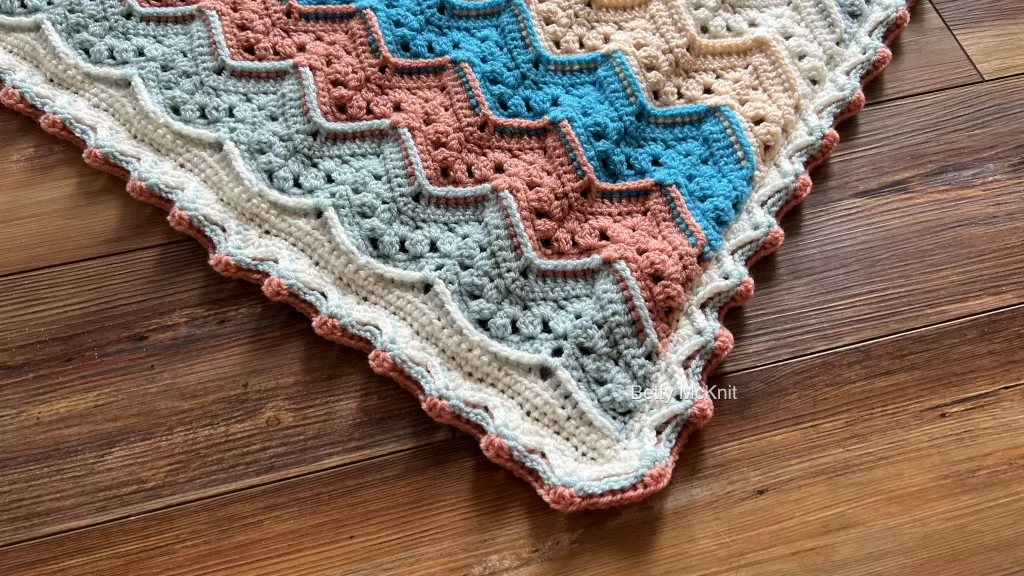
Begin
Starting with Color A and larger hook, ch 147 (Multiple of 13 + 4)
Setup Row 1: starting in second ch from hook, sc across.
Turn
Switch to smaller hook.
From this point forward, unless stated otherwise, start your first st in the st below the turning ch.
Setup Row 2: ch 1, 5 sc, 6 hdc, *7 sc, 6 hdc, repeat from * to last 5 sts, 5 sc.
Turn
Setup Row 3: ch 1, 3 sc, *3 hdc, 2 dc, ch 2, 2 dc, 3 hdc, sc, sl st, sc, repeat from * to last 3 sts, 3 sc.
Turn
Change to Color B
Setup Row 4: ch 1, sc, 2 FPsc, *3 FPhdc, 2 FPdc, (dc, ch 1, dc) in ch 2 sp, 2 FPdc, 3 FPhdc, FPsc, sk 1, FPsc, repeat from * until 3 sts remain, 2 FPsc, sc in last st.
Turn
Setup Row 5: ch 1, sc in same st, sk 1, 7 sc, *3 sc in ch sp, 14 sc, repeat from * to last peak, 3 sc in ch sp, 7 sc, sk 1, sc
Turn
Proceed to Row 2
Row 2: ch 3, sk first 3 sc (the sc on the end of the row, the one below your turning chain counts as 1)
(3 dc in next sc, sk next 2 sc) twice, (3 dc, ch 3, 3 dc) into next sc
*sk next 2 sc, 3 dc into next sc, sk next 2 sc, dc3tog,
sk next 4 sc, dc3tog, sk next 2 sc, 3 dc in next sc, sk next 2 sc, (3 dc, ch 3, 3 dc) into next sc; rep from * to last 9 sc
sk next 2 sc (3 dc into next sc, sk next 2 sc) twice, dc in last sc.
Turn

Row 3: ch 3, sk sp between turning ch and next 3 dc group, 3 dc into each of next 2 sps,
(3 dc, ch 3, 3 dc) into ch 3 sp, *3 dc into next sp, dc3tog into next sp
sk next sp, dc3tog into next sp, 3 dc into next sp, (3 dc, ch 3, 3 dc) into next ch 3 sp
rep from * to last 3 sps, 3 dc into each of next 2 sps
1 dc into sp between last 3 dc group and turning ch.
Turn
Row 4: ch 1, sc into first dc of the row (the one right below your turning chain)
sk next dc, 1 sc into each of next 8 dc
*3 sc into next ch 3 sp, 1 sc into each of next 14 sts
repeat from * to last ch 3 sp, 3 sc into last ch 3 sp
1 sc into each of next 8 dc, sk next dc, sc into top of turning ch.
Turn
Row 5: Ch 3, sk 2, (the sc your turning chain is coming out of counts as the first one). 1 dc into each of next 8 sc
*3 dc into next sc (you should be working these into the center stitch of the 3 sc. If not, you may have skipped incorrectly in the beginning of the row.) 1 dc into each of next 7 sc
sk next 2 sc, 1 dc into each of next 7 sc
rep from * to last 11 sc, 3 dc into next sc, 1 dc into each of next 8 sc
sk 1, dc in last st.
Turn
Change to Color C
Row 6: Ch 3, sk first 2 dc (the dc below your turning chain counts as 1)
FPdc into each of next 8 dc
*3 dc into next dc (you should be working into center stitch of 3 dc)
FPdc into each of next 7 dc, sk next 2 dc, FPdc into each of next 7 dc
rep from * to last 10 dc
3 dc into next dc, FPdc into each of next 8 dc, sk last dc, dc in top of turning ch.
Turn
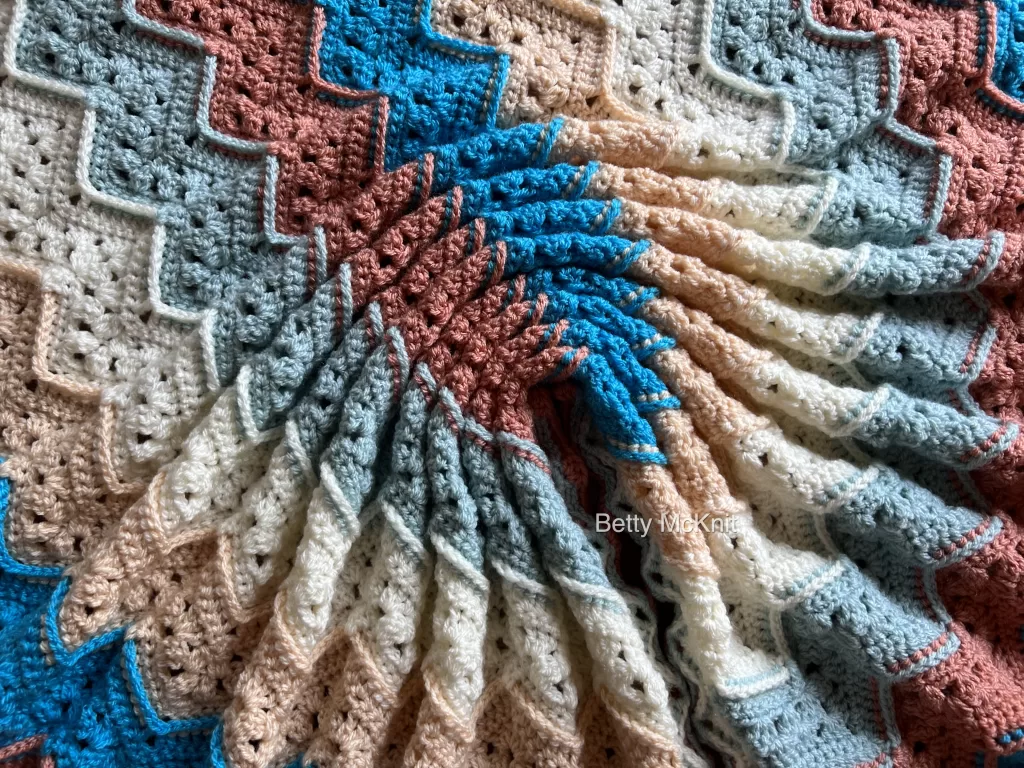
Row 7: Ch 1, sc into first dc (the same one the turning chain is coming out of), sk 1, sc into each dc along row to last dc, sk last dc, 1 sc into top of turning ch.
Turn.
Repeat rows 2-7 changing colors after row 5 each time, working colors in order changing to color D next, then E, then ABCDE, then ABCD, and change to Color E for rows 6 and 7.
Repeat rows 2-4 in Color E. For straight top, do not fasten off, continue to Top Edge Rows with Color E. If you started with a chevron start and would like to end with one, you can end here.
Top Edge:
Top Edge Row 1: Continuing in Color E, Ch 3. Counting the stitch under the turning chain, sk 2, 4 dc, 3 hdc, 3 sc, *3 hdc, 3 dc, sk 2, 3 dc, 3 hdc, 3 sc, repeat from * to last 9 sts, 3 hdc, 4 dc, sk 1, dc in last sc.
Turn
Change to Color A
Top Edge Row 2: Ch 3, counting the stitch under the turning chain, sk 2, 3 FPdc, 3 FPhdc, FPsc, sc, FPsc, *3 FPhdc, 2 FPdc, sk 2, 2 FPdc, 3 FPhdc, FPsc, sc, FPsc, repeat from * to last 8 sts, 3 FPhdc, 3 FPdc, sk 1, dc in turning ch.
Turn
Top Edge Row 3:
Ch 3, counting the stitch below the turning chain, sk 2, 3 hdc, 7 sc, *6 hdc, 7 sc repeat from * until 5 st remain, 3 hdc, sk 1, hdc in turning ch.
Turn
Top Edge Row 4:
Ch 1, sc across to last sc.
Turn
Top Edge Row 5:
Ch 1, sc across to last sc.
Turn
Continue to Border Round 1 with Color A.
Border
Border Round 1:
With ridge side facing, join Color A with sc to top left corner of the blanket. Working down the left side, sc down the side of the blanket. Treating the turning chains and the sc and dc stitches like foundation chains, work sc under 2 threads of each stitch and leave one thread below. This creates a beautiful even edge to the work. The number of sc you will put in each stitch will vary depending on your tension, but a general rule is 2 sc per dc, 2 sc per turning ch, and 1 sc per sc. Lay your work down often to check that your edge is laying flat and adjust the number of stitches accordingly. Work 3 sc into each corner of the blanket and continue across the bottom and right side of the blanket. Finish with 2 sc in the same sp as the first sc of top edge row 4, join with sl st. Do not fasten off or turn.
Border Round 2: (Continuing Color A)
*sk 2, (3 dc, ch 3, 3 dc) in next st, sk 2, sc in next st. Repeat from * around. Adjust your skips so that the sc lands in the corner sts. Join with sl st to first dc.
Change to Color B
Border Round 3: Join with sc to any ch 3 sp. 2 sc in same sp. *BPsc, BPhdc, BPdc, sk 1, BPdc, BPhdc, BPsc, 3 sc in ch 3 sp. Repeat from * around, ending with BPsc. Join with sl st to first sc. Fasten off.
Change to Color C
Final Border Round: Join Color C with hdc in center sc in any peak, 2 hdc in same st. *sk1, 6 BPhdc, sk 1, 3 hdc in center sc of peak. Repeat from * around ending with 6 BPhdc. Join with sl st to first hdc. Fasten off.
Weave in all ends.
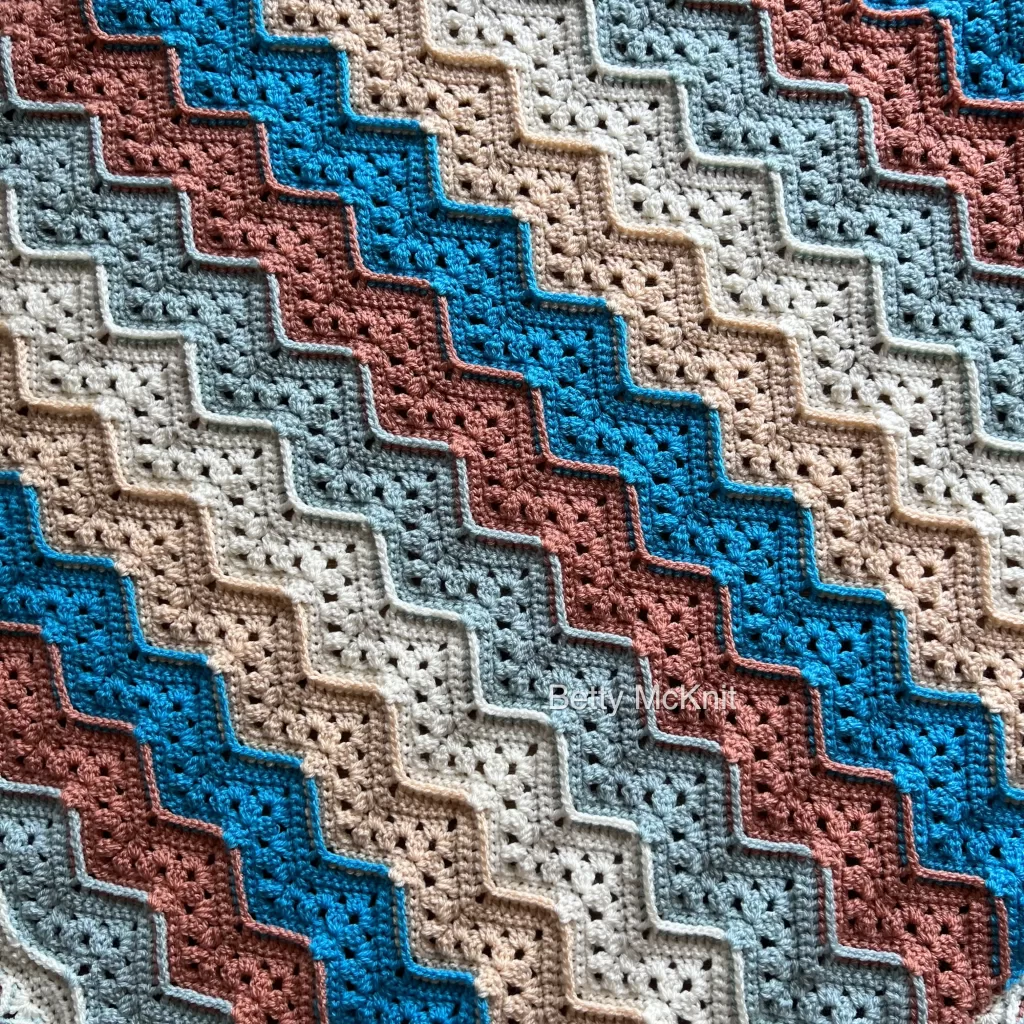
Beth McKee Elliott
aka Betty McKnit
Beth McKee Elliott, also known as Betty McKnit, is a crochet and knitting designer, instructor, community leader, and Master Somatic Movement Therapist and Educator. Her signature style, 6-Day Crochet, is showcased in the viral crochet patterns the 6-Day Kid Blanket and 6-Day Star Blanket.
She specializes in Somatic Crochet and Knitting, a mindfulness practice that combines crochet/knitting with body awareness techniques to prevent injury and promote well-being and creativity in crafting.
In addition to being a crochet designer, Beth is a choreographer. She is the creator and director of Small Plates Choreography Festival, Haven Movement Company, and the Dance Maker Podcast.
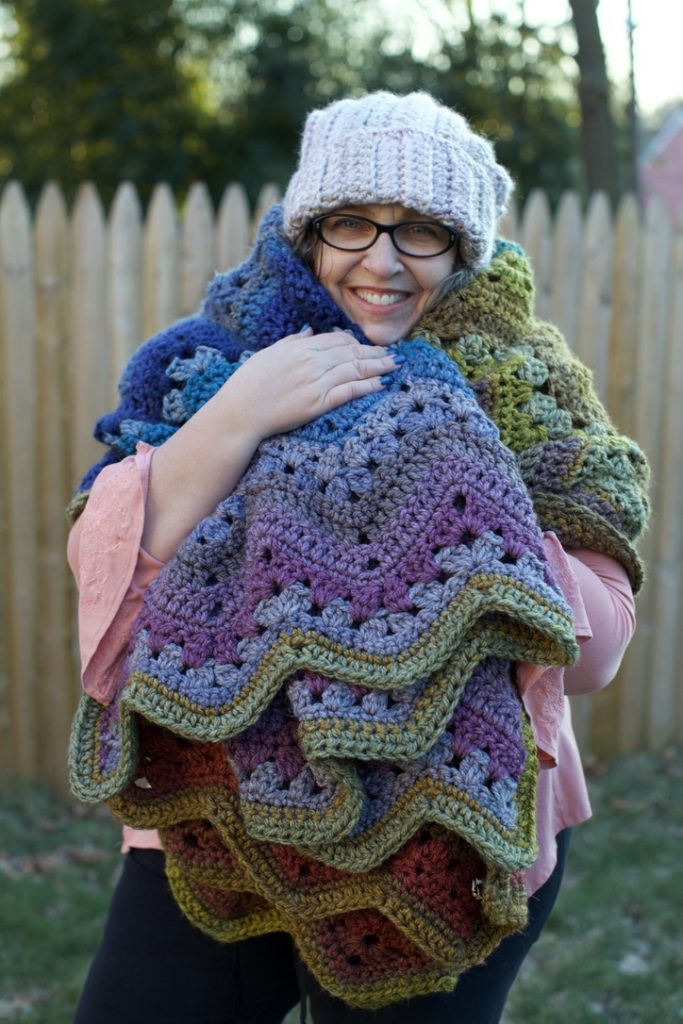
This page contains affiliate links. If you click these links and buy something on the page they take you to, I may, at no additional cost to you, earn a commission. I only affiliate with products and companies I feel good about. Thank you for your support!
The Ridgy Didge Stripe was conceptualized by Diane Kagay and members of the 6-Day Kid Blanket Community. The name was suggested by Sue McKinnon and Katie Poli. Thank you to Erin our members for their creative contributions to the 6-Day Kid Blanket family of patterns, including Erin Iske and Stephanie Pundt-Warner who also created and posted many beautiful 6-Day Kid Blankets with textured rows.
Join us in the 6-Day Kid Blanket Facebook Group for help with this pattern, to show off your finished creations, and to see more options for texture. Be sure to tag @bettymcknit in your social media posts
Video tutorials available on my YouTube Channel.
This pattern contains affiliate links. If you click these links and buy something on the page they take you to, I may, at no additional cost to you, earn a commission. I only affiliate with products and companies I feel good about. Thank you for your support!
This pattern is the intellectual property of Betty McKnit/Beth Elliott. This pattern, The 6-Day Kid Blanket, “6DKB” and derivative works are also protected by copyright. Publishing translations, corrections, variations, or tutorials of this pattern, online or elsewhere without written permission from the owner is a violation of copyright.
The stitch pattern is “Vivid Chevrons” #110 from 200 Ripple Stitch Patterns by Jan Eaton.Reprinted with permission from Quarto Publishing.


